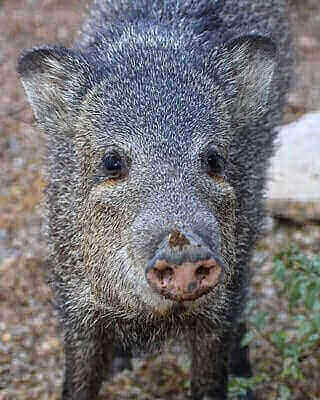Disclosure: We may earn commissions if you purchase products after clicking on a link from our site.
Are you ready to learn how to hunt javelinas like a pro? Hunting javelinas can be an exhilarating adventure for any outdoor enthusiast, but mastering the art requires the right knowledge and strategies.
With our comprehensive guide, you’ll discover everything you need to know to embark on a successful javelina hunting expedition. From understanding their behavior to selecting the right equipment and tactics, we’ve got you covered every step of the way.
Get ready to immerse yourself in the thrilling world of javelina hunting and unlock the secrets to a rewarding and unforgettable hunting experience. Javelinas are members of the peccary family. In this article, we share points on how to hunt javelinas to improve your chances of success.
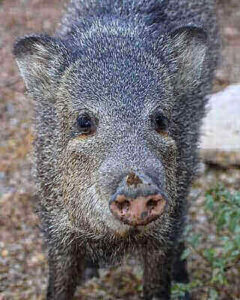
Table of Contents
How To Hunt Javelinas
1. Scouting
Scouting javelinas is an essential aspect of preparing for a successful hunt. These small, elusive creatures often inhabit arid regions, dense brush, and desert environments, making them challenging to locate.
To effectively scout for javelinas, hunters should focus on areas with ample food sources such as cactus, mesquite, and other desert vegetation. Look for tracks, droppings, and signs of rooting activity to identify their presence in the area.
Additionally, scouting during early morning or late afternoon when javelinas are most active can increase your chances of spotting them. Utilize binoculars to scan the terrain from elevated vantage points, such as hillsides or ridges, and be prepared for a close encounter as javelinas tend to travel in small groups called “sounders.” By dedicating time to thorough scouting, hunters can gather valuable intel to inform their hunting strategy and increase their chances of a successful javelina harvest.
2. Spot & Stalk
One of the best ways to hunt javelinas is the spot-and-stalk method. Find a high elevation with clear views and use binoculars or a spotting scope to glass for javelinas. Once you spot a javelina, just make a mental note that there may be others not very far off. Slowly and quietly stalk it while you keep your eyes open for the rest of the herd. Javelinas are small, dark, and low to the ground.
They blend with their surroundings very well. As you glass an area, don’t disregard any strange shapes or dark patches. They are difficult to spot in thick scrub; therefore carefully study the area with your binoculars.
Additionally, javelinas are vocal with the sounds of grunts and snorts. When you are learning how to hunt javelinas, you will realize that they just might give away their location from the sounds of their chewing, snorts, and grunts.
3. Javelinas & the Weather
Understanding javelina’s behavior about the weather is crucial for a successful hunt. Javelinas are highly sensitive to temperature fluctuations and weather conditions, often adjusting their activity patterns accordingly.
During hot weather, javelinas tend to be more active during the cooler hours of dawn and dusk, seeking shelter in dense vegetation or shady areas during the heat of the day. Conversely, in colder weather, javelinas may be more active throughout the day, especially during periods of mild temperatures.
Rainfall can also influence javelina behavior, as they may become more active following precipitation to forage for fresh vegetation or to take advantage of softened soil for rooting. Understanding these behavioral patterns allows hunters to adjust their hunting strategies accordingly, focusing their efforts during peak activity periods and targeting areas where javelinas are likely to be seeking shelter or foraging based on prevailing weather conditions.
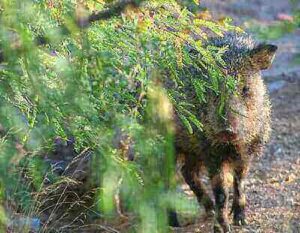
4. Wind Direction
Understanding and monitoring wind direction is crucial when hunting javelinas as it can significantly impact the success of the hunt. Javelinas possess a keen sense of smell, which they rely on heavily to detect potential threats in their environment.
By being aware of the wind direction, hunters can position themselves strategically to ensure that their scent is carried away from the targeted javelinas. This reduces the risk of alerting the animals to their presence and increases the likelihood of a successful stalk or ambush. Hunting with the wind at your back or quartering away from the javelinas allows for a more stealthy approach and minimizes the risk of being detected by these wary creatures.
Additionally, hunters should be prepared to adjust their positioning and tactics based on changes in wind direction throughout the hunt to maintain the element of surprise and increase their chances of a successful harvest.
5. Javelina Odor
Javelinas are known for their distinct odor, which is often described as musky or pungent. This unique scent is produced by specialized scent glands located on the animal’s back and near its eyes. The odor serves various purposes in javelina communication and social interactions, including marking territory, identifying group members, and signaling reproductive readiness.
While the odor may be off-putting to some, it plays a crucial role in the javelina’s survival and social dynamics. For hunters, recognizing and understanding the javelina’s odor can provide valuable clues about their presence in the area and help inform hunting strategies. Additionally, being aware of the scent can help hunters mask their odor to avoid detection by these keen-nosed animals during a hunt.
6. Predator Calls
A distressed call of a struggling javelina will almost always result in an immediate response of a herd of javelinas charging in the direction of the sound of the call. Be prepared to take a shot when you make the distressed call. This is one of the best tips to remember when you are learning how to hunt javelinas.
Using predator calls can be an effective strategy when hunting javelinas, as these animals are naturally curious and may investigate the sounds of potential threats or rivals. Predator calls such as distress calls of small mammals or young javelinas can pique the interest of javelinas, drawing them closer to investigate the source of the sound.
Additionally, using coyote or bobcat calls can simulate the presence of predators, triggering defensive or territorial responses from nearby javelina groups. When using predator calls, hunters should position themselves downwind of the anticipated approach path of the javelinas and remain patient, allowing enough time for the animals to respond and approach within shooting range. By effectively utilizing predator calls, hunters can enhance their chances of luring javelinas into range for a successful harvest.
After locating a javelina herd, stalk them unnoticed to within 75 yards of them. Get your firearm or bow ready, and then blow the distressed call. You can read a review of the best predator calls on the market today from this link.
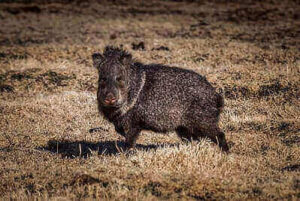
7. Bait
Using bait can be an effective method for hunting javelinas, especially in areas where their natural food sources are scarce or where they’ve become accustomed to scavenging for human-related food. Common baits for javelinas include corn, fruit, grains, and specialized attractants designed to lure them in.
Hunters typically scatter the bait in areas frequented by javelinas, such as game trails, watering holes, or near bedding areas. Additionally, bait can be placed strategically within the shooting range of a hunter’s blind or stand to increase the likelihood of a close-range shot.
When using bait, it’s essential to monitor local regulations and ethical guidelines to ensure legal and responsible hunting practices. Additionally, hunters should exercise patience and remain concealed while waiting for javelinas to approach the bait, as these animals can be wary when sensing potential danger.
8. Weapon
A rifle, handgun, crossbow, or bow can be used to hunt javelinas. Rifles with .25 and .257 calibers are just some that can be used to hunt javelinas. The single-shot handguns with centerfire rifle cartridges like .257, and .308 can also be used.
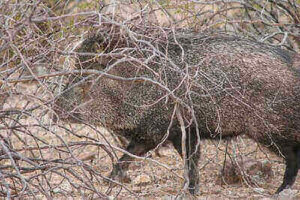
Javelina Hunting Tips
1. Javelinas can be found in thick brush and rocky overhangs.
2. Javelinas have a very strong and stinky odor from their scent glands. When you are searching for them and you pick up a stinking odor, it might be that you are close to a herd.
3. Javelinas eat plants and animals. When you are scouting for them, look for rooted-up grounds, overturned cow pies, shredded sotol, agave plants, and chewed paddles of prickly pear cactus.
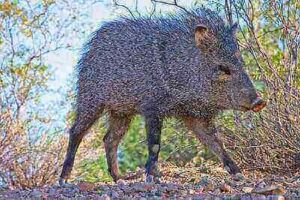
4. Binoculars or a spotting scope can be used to glass for javelinas from an elevated position. Reviews of the best hunting binoculars and best spotting scopes can be found from these links.
5. The spot and stalk hunting method is the most effective way of hunting javelinas.
6. Javelinas are poorly insulated. When you are looking for them, pay attention to the weather. They won’t come out on frigid mornings and very hot days.
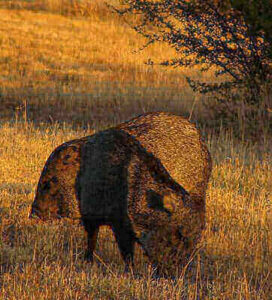
7. Always stalk javelinas downwind of them.
8. When glassing for javelinas and you spot one, just know that others may not be very far away.
9. Javelinas are small, dark, and low to the ground. When you are glassing for them, carefully study any strange shapes or dark patches. When learning how to hunt javelinas, you will often spot javelinas as dark patches and don’t realize it is a javelina. But with more experience, you will know right away it is one.
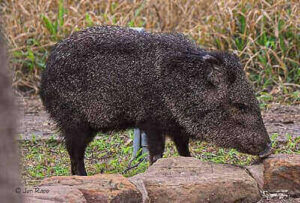
10. When shooting a javelina in thick cover, carefully verify the target and make sure another javelina is not standing behind the one you are aiming at. A bullet can easily pass through one and kill another standing behind your target.
11. You can use distressed and struggling javelina calls to get a response from a herd of javelinas.
12. Javelinas make a good amount of noise when chewing, snorting, or making grunts. They may just give away their location with the noise they make.
13. Javelinas have poor eyesight. This allows bow hunters to get close for a good shot. You will realize this when you are learning how to hunt javelinas. You can take advantage of their poor eyesight and get close enough for a good shot.
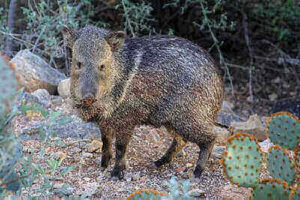
The Bottom Line
Hunting javelinas are not like the regular hunt of deer, elk or mountain goats, or hogs. They are challenging and unique. Like wolves, they are not alone and are usually in a herd and are omnivores.
In this article, we discussed how to hunt javelinas to help you be successful in hunting them. If you are interested in hunting hogs, you can read about how to hunt hogs. You can also read how to hunt beavers, how to hunt raccoons, how to hunt mountain goats, how to hunt aoudad, and how to hunt wild sheep.
